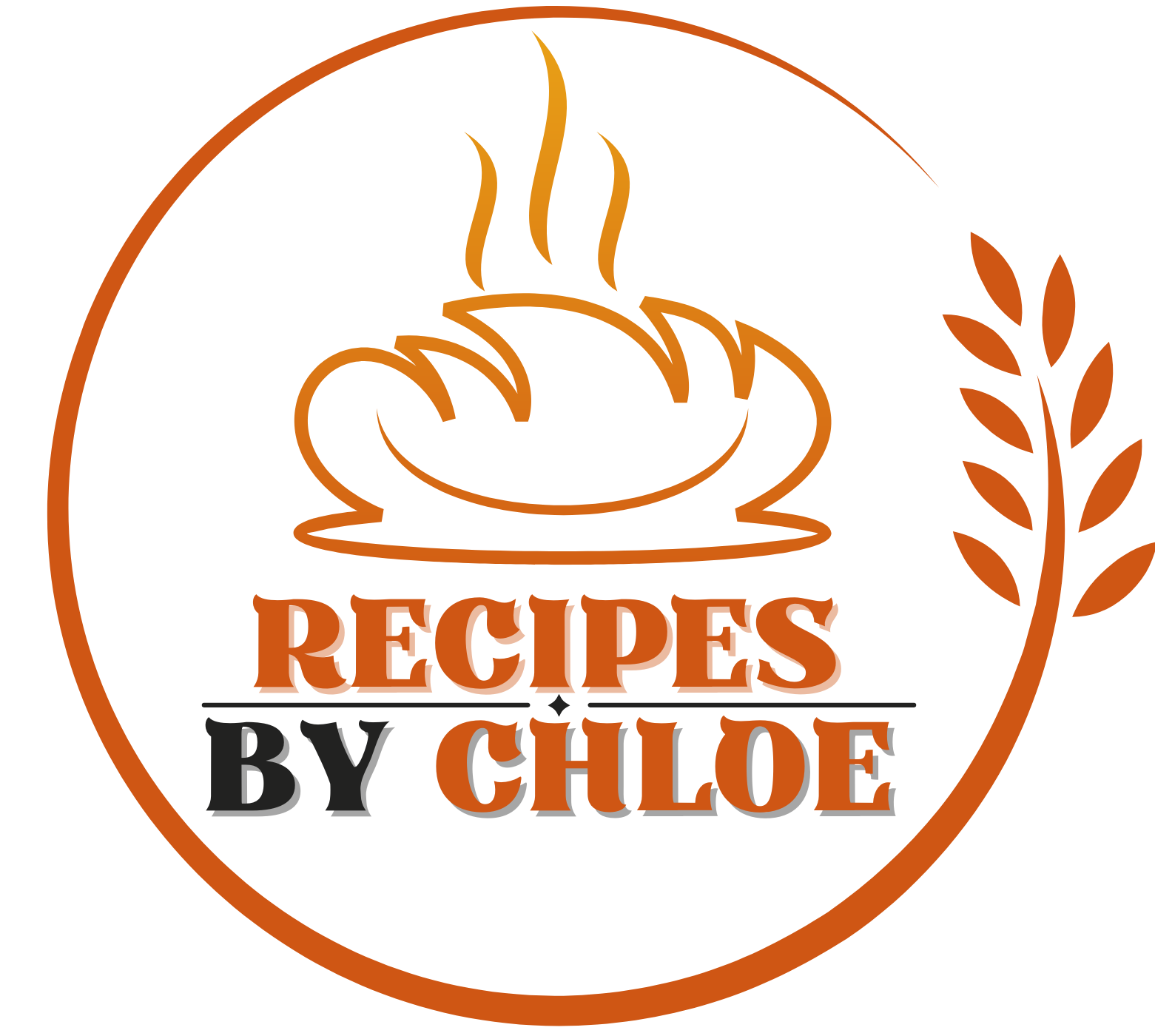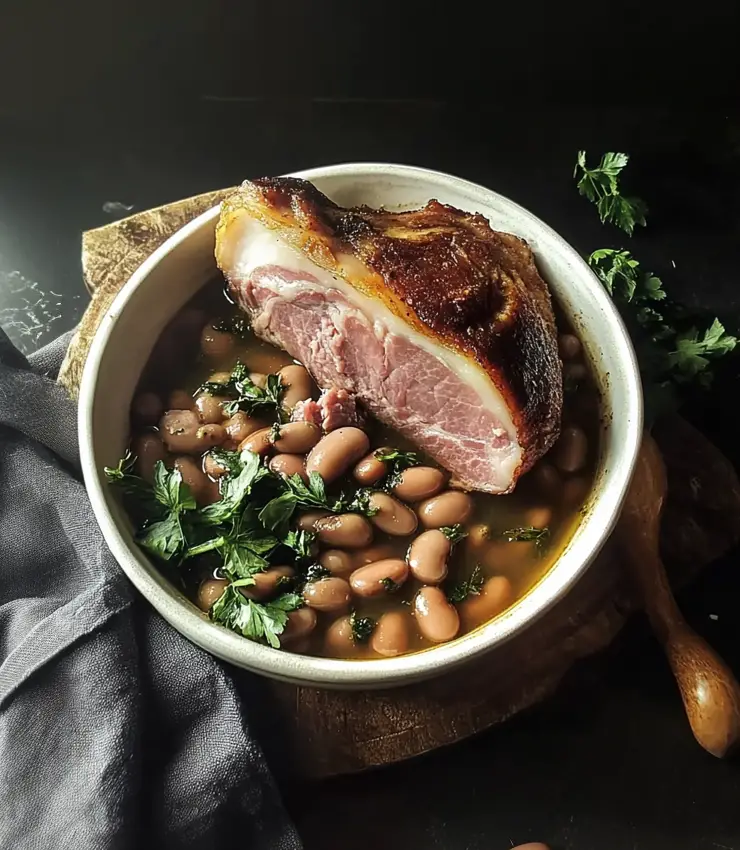Beans Cooked with Ham Hock is a classic comfort dish that brings together the smoky richness of ham hock and the hearty texture of pinto beans. Slow-cooked to perfection, this meal is ideal for cozy dinners or as a satisfying side. Its deep flavors and simple ingredients make it a staple in Southern cuisine.
Full Recipe:
Ingredients
- 1 pound dried pinto beans, rinsed and soaked overnight
- 1 smoked ham hock
- 1 large onion, chopped
- 3 cloves garlic, minced
- 1 teaspoon chili powder
- 1/2 teaspoon black pepper
- 6 cups water
- Salt to taste
- Fresh parsley, chopped, for garnish
Directions
- Prepare the Beans: Drain and rinse the soaked beans.
- Combine Ingredients: In a large pot, add the beans, smoked ham hock, onion, garlic, chili powder, black pepper, and water.
- Cook the Beans: Bring the mixture to a boil, then reduce the heat to low. Cover and let simmer for 2-3 hours, or until the beans are tender and the meat is falling off the ham hock.
- Finish the Dish: Remove the ham hock from the pot. Shred any meat from the bone and return the meat to the pot. Discard the bone. Season with salt to taste.
- Serve: Stir the beans well and serve hot, garnished with chopped parsley.
Nutrients
Note: Nutritional values are approximate and can vary based on specific ingredients used.
- Calories: Approximately 540 kcal per serving
- Total Fat: 21g
- Saturated Fat: 7g
- Cholesterol: 70mg
- Sodium: 750mg
- Total Carbohydrates: 45g
- Dietary Fiber: 11g
- Sugars: 3g
- Protein: 41g
Historical and Cultural Significance
The dish of beans cooked with ham hock has origins tied to Southern and soul food traditions in the United States. Historically, the ham hock, which is the joint between the tibia/fibula and the metatarsals of the pig’s foot, was considered a less desirable cut of meat because of its toughness and abundance of connective tissue. However, when cooked slowly over time, this cut imparts incredible smoky flavor and richness to dishes, especially stews and beans.
In many Southern households, beans and ham hock are staples, often served as a main dish or a hearty side. This recipe reflects a culinary philosophy centered on making the most out of available ingredients, highlighting slow cooking as a technique that transforms tough meat into tender, flavorful bites. It also represents a way of cooking that brings families together, as the long simmering time fills the home with comforting aromas, making it perfect for gatherings and communal meals.
Flavor Profile and Cooking Technique
The beauty of beans cooked with ham hock lies in its layered flavors. The smoky, salty essence from the ham hock slowly infuses the beans, creating a rich broth that enhances the natural earthiness of the beans themselves. The addition of aromatics like onions and garlic builds complexity, while subtle spices such as chili powder and black pepper add warmth without overpowering the dish.
Slow simmering is the key to unlocking these flavors. Cooking the beans and ham hock gently for several hours allows the connective tissues in the ham hock to break down, releasing gelatin and natural fats that thicken the broth and provide a silky mouthfeel. Meanwhile, the beans soften to a creamy texture but still hold their shape, striking a perfect balance.
This technique also makes the dish highly versatile. You can adjust the seasoning, add different types of beans, or incorporate vegetables such as tomatoes, bell peppers, or greens to customize it further. It can be served as a wholesome main course or as a side to complement other Southern classics like cornbread, collard greens, or fried chicken.
Nutritional Benefits
Beans cooked with ham hock is a nutritional powerhouse. Beans themselves are rich in protein, fiber, vitamins, and minerals, making them an excellent plant-based source of nutrition. They support digestive health, provide sustained energy, and are beneficial for heart health due to their low fat and high fiber content.
The ham hock adds a significant source of animal protein and contributes essential minerals such as iron, zinc, and B vitamins. However, it also adds fat and sodium, which should be moderated depending on dietary needs. Together, the beans and ham hock create a balanced dish that provides both macronutrients and micronutrients, making it ideal for people seeking hearty yet nutritious meals.
In addition, the slow cooking process helps retain most of the nutrients, as it doesn’t involve harsh cooking methods like frying or boiling at high heat. The combination of protein and fiber also helps keep you full longer, which can aid in weight management by reducing unnecessary snacking.
Culinary Variations and Adaptations
While the classic beans and ham hock recipe is beloved in its traditional form, many variations have emerged across regions and personal preferences. Some versions add tomatoes or tomato paste for a tangy undertone, while others include smoked sausage or bacon alongside the ham hock for extra smoky flavor.
In some households, greens like kale or mustard greens are stirred in towards the end of cooking, adding a fresh and slightly bitter contrast to the rich beans. Spices can also be tailored — from adding a bit of cayenne pepper for heat to experimenting with herbs like thyme or bay leaves for additional depth.
For those who prefer a leaner option, the ham hock can be substituted with smoked turkey legs or necks, which provide a similar smoky flavor with less fat. Vegetarian versions omit the meat altogether, relying on smoked paprika or liquid smoke to replicate the savory essence.
Serving Suggestions
Beans cooked with ham hock is incredibly versatile in how it can be served. Traditionally, it pairs beautifully with cornbread — the slightly sweet and crumbly bread perfectly complements the savory beans. It can also be served over steamed rice for a filling meal or alongside roasted vegetables for added nutrition.
This dish is perfect for family dinners, potlucks, and cold-weather meals due to its warming qualities. Leftovers often taste even better the next day as the flavors continue to meld and deepen.
For a more modern twist, the beans can be turned into a hearty bean dip or spread, perfect for appetizers or party platters. Additionally, spooning the beans over baked potatoes or stuffing them into burritos are delicious ways to enjoy this classic dish.
Health Considerations
While beans cooked with ham hock is nutritious, there are a few health considerations to keep in mind. Ham hocks can be high in sodium, which may not be suitable for individuals with hypertension or those on sodium-restricted diets. It’s important to adjust seasoning accordingly and consider rinsing the cooked beans lightly to reduce excess salt if necessary.
Also, because ham hock contains saturated fats, moderation is key for heart health. Pairing this dish with plenty of vegetables and whole grains can help balance out the meal. Drinking plenty of water and maintaining an overall balanced diet will maximize the health benefits while enjoying this flavorful dish.
Why This Recipe Remains Popular
The enduring popularity of beans cooked with ham hock can be attributed to several factors. First, it is a one-pot meal that requires relatively simple preparation but yields complex and satisfying flavors. Second, it’s highly affordable, using inexpensive ingredients that stretch well to feed families or larger groups. The dish also appeals to a broad range of tastes, from those who love traditional Southern fare to people seeking comfort food with a wholesome twist. Its hearty nature makes it especially appealing in cooler months, while the nutritional benefits align well with modern health-conscious eating habits.
Conclusion
Beans cooked with ham hock is much more than a simple bean stew. It embodies tradition, resourcefulness, and comfort, bringing together smoky, savory flavors and wholesome nutrition in a single pot. This dish honors a rich culinary heritage while remaining adaptable to modern tastes and dietary needs.






